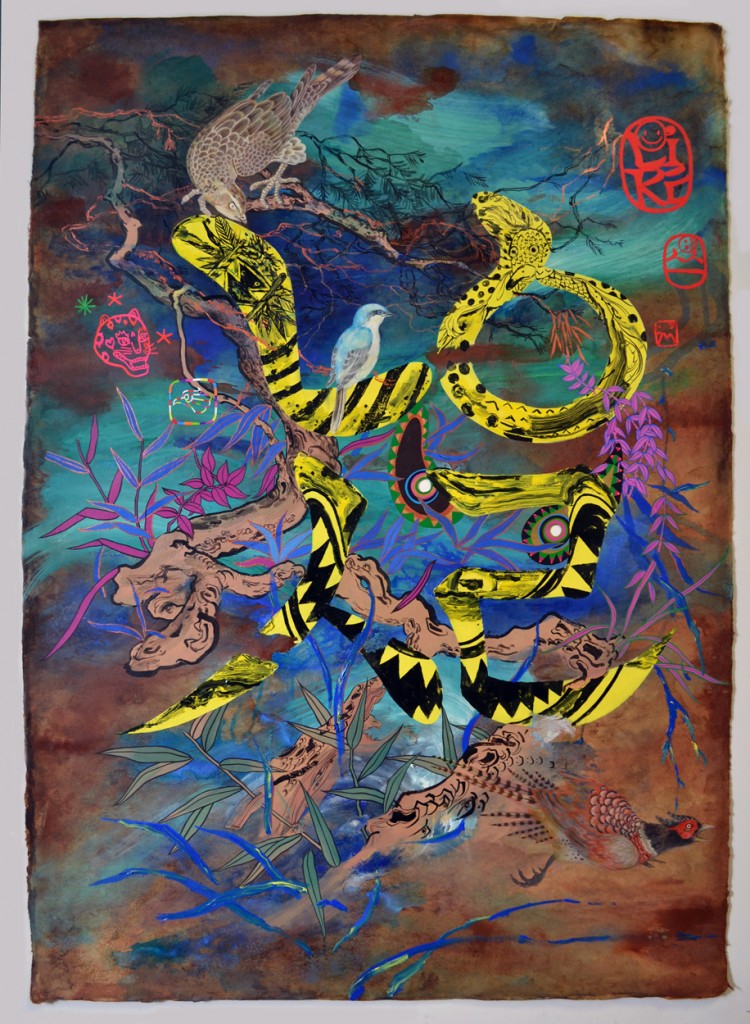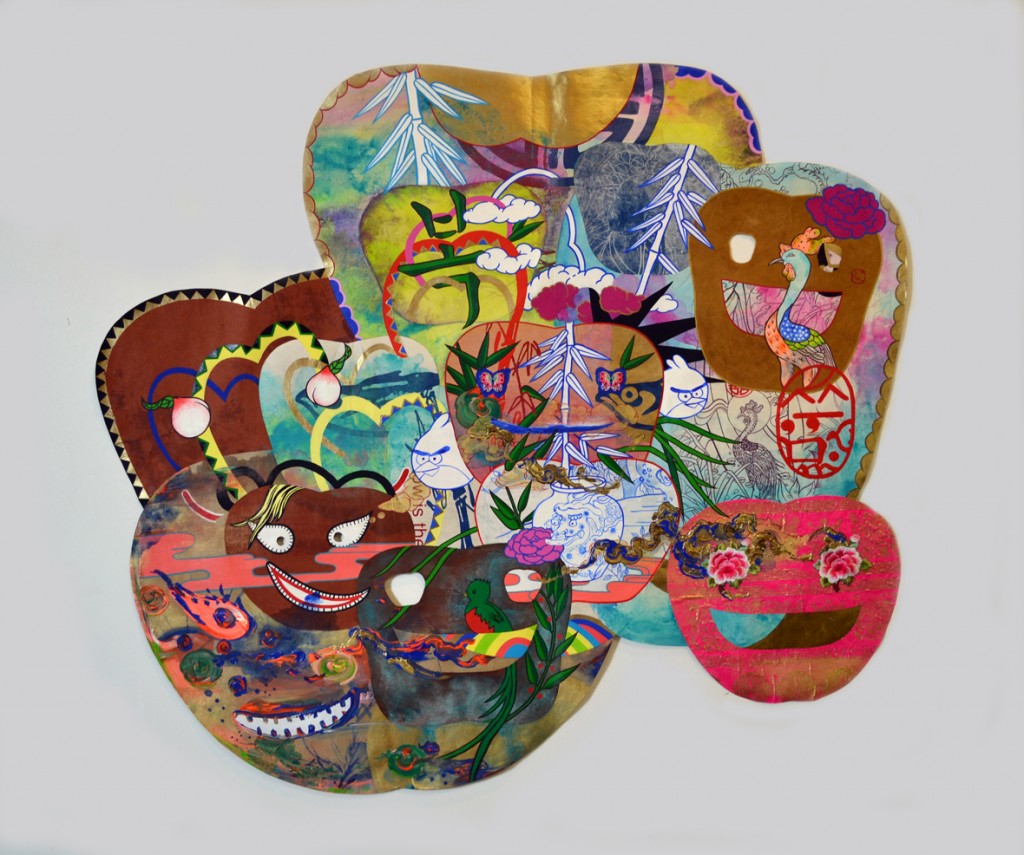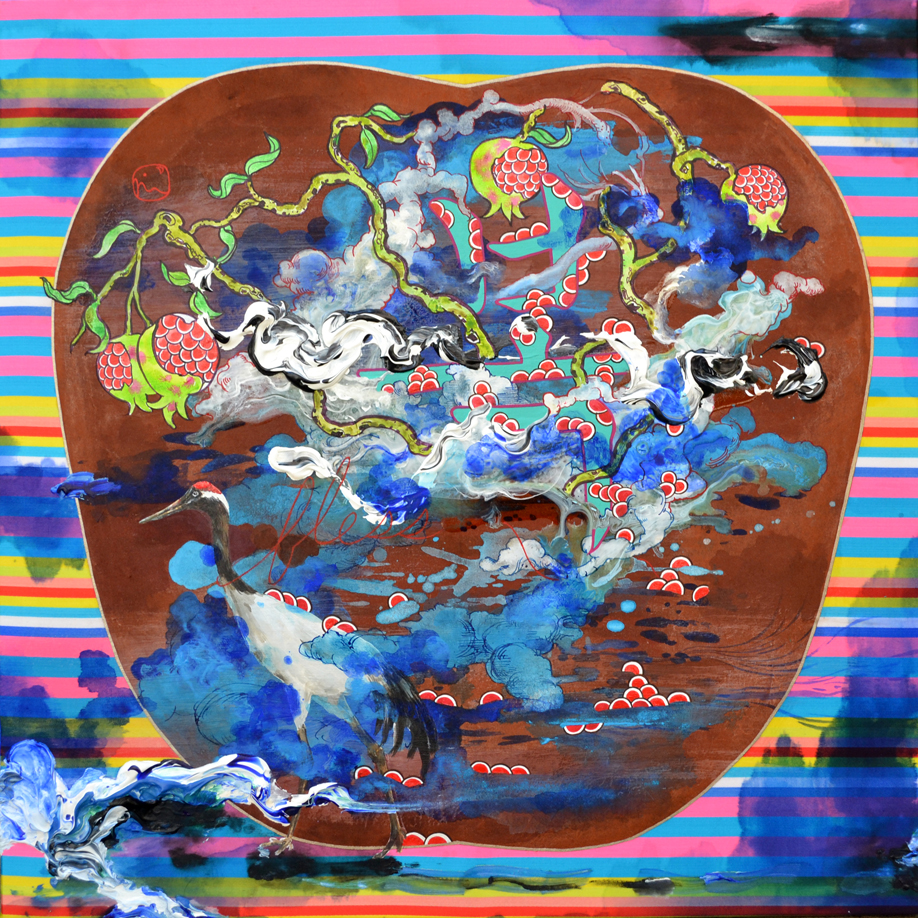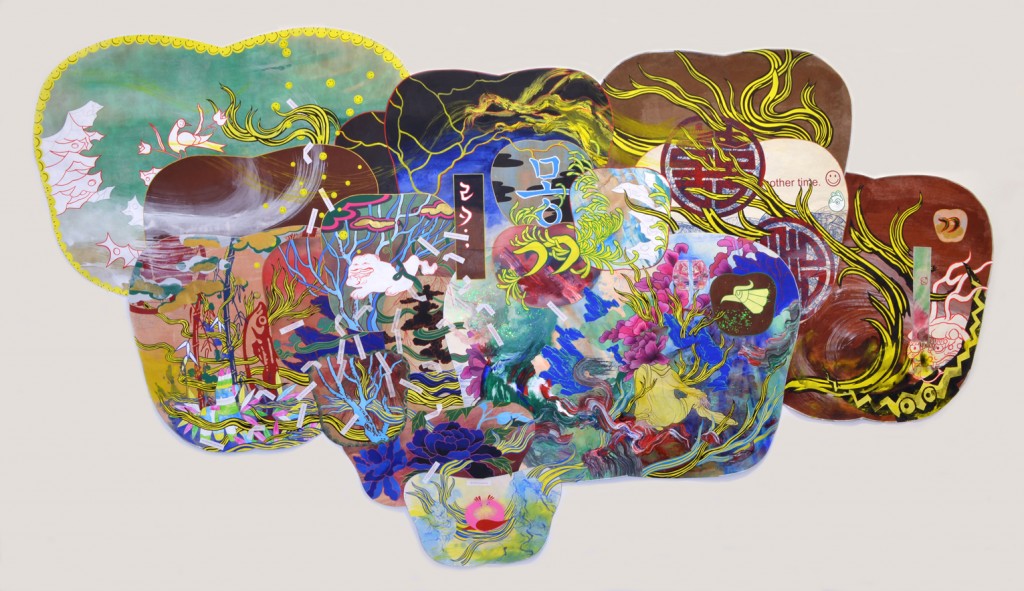With bright colors and textures, artist Jiha Moon seamlessly blends heritage and the modern world into her work. She uses paper and other traditional materials from South Korea and layers them with paint in intricate ways—without a canvas. With an MFA from the University of Iowa, Moon was a recent MOCA GA Working Artist project award winner, and her opening solo show, “Foreign Love,” on Sept. 6 will be part of it. In it, she examines our perspective of foreign things, being authentic and how the unfamiliar relates to personal experience. A native of South Korea, Moon’s work has been shown all over the world, from Germany to Asia, but she and her family call Atlanta home.
CommonCreativ talks to Moon about heritage, communicating through colors, how Atlanta is growing artistically and her new show.
CommonCreativ: Tell me how you ended up as an artist.
Jiha Moon: I have been drawing and painting since I was a little kid. And I have always gotten attention for it. As a middle child, that was almost my strength to get attention from my parents and family. It naturally became an important part of me and I ended up being an artist. I’m from a city called “Daegu” which is the sister city to Atlanta in South Korea. I came here when I was 26 to attend graduate school at the University of Iowa for an MFA and met my husband, Andy Moon Wilson. We settled in the U.S. and we have a 5-year-old, Oliver.
CC: What are your favorite materials to work with?
JM: As a painter, colors are my main materials. I use colors to communicate with people [and share] information, experience and emotion. The combinations of color that can be used to reference information are endless. It is important to use those in my work. It is part of my visual language.
Technically, my main materials are Korean mulberry paper called “Hanji” from Korea, along with ink and acrylic paint. Hanji has a long history, more than 1,000 years, and acrylic has relatively short history of less than 100 years. I love how perfectly married they are in my work. I have been also using different fabrics, embroidery patches from Korea and craft stores in America, scrapbooking materials and things like that for my work on paper sometimes.
For my other projects for MOCA GA show, I have enjoyed working on ceramic sculptures. I have been going to MudFire in Decatur since last summer. Oh, also, I have been making funky objects based on Korean ornaments called Norigae out of hair and ceramic. Traditionally these are made from silk rope for the knotted part and jade or gold for the body part.
CC: How has your heritage influenced your art?
JM: When I was in Korea, my work was entirely different than it is now. I think I got interested in Korean art and traditional elements after I moved to the U.S. It’s funny, when I go visit Korea, I totally feel like a tourist, even though I grew up there and lived there for 26 years. I call Korea home when I am here but I call America home when I visit there. So, of course, the traditions and cultures of Korea and America are both big influences on my work, but it gets more complex and interesting because I combine and add other cultures as I experience every day here. I love living in America for that reason. It is much more diverse here than it is in Korea, all kinds of everything are here and different people’s voices can be heard.
CC: What’s your artistic process when you’re getting ready for a show?
JM: For my main body of work on paper I usually work on two or three different series at a time. All of my different projects affect each other and sometimes I find interesting overlaps among them that lead to new directions in my work. I explore the interactions of all these different things and try to incorporate them in interesting ways. I try not to make works that are specifically “about something “or making works that focus on only one theme—I find that limiting. My work is about complex interactions between disparate concepts and elements, and it is never about one thing. I often realize that after I finish a new body of work or finish works for a show it takes time for me to digest and understand what I’ve done or recognize what I’ve been searching for. This thought process is often the starting point for my next project.
CC: Tell me a bit more about your upcoming exhibition at MOCA GA, “Foreign Love.”
JM: This exhibition consists of three parts: my main and usual work on paper, Norigae as art objects (influenced by Korean women’s ornaments) and an installation of ceramic sculpture.
The whole time I’ve been working on this project, which has taken almost a year, I have been thinking about why people love foreign stuff so much. When we travel to other countries, explore different cultures and meet with new people, we tend to fall in love with things that are not our own. People have a soft spot for foreign things. I feel that it is because we add our own experience and imagination to the unfamiliar, which can lead us to misunderstanding. It’s much like tourism. As a foreigner living in the States myself, I often think about what authenticity really means and [I think] we often misunderstand it.
So, the overall theme of the works in this show is that they might appear foreign and exotic, or they might look familiar and comforting, but you have to look carefully to understand what you’re really experiencing. I don’t have the answers because I ask myself the same questions. Ultimately, everyone except ourselves is foreign. Examining misunderstanding is part of the necessary process of understanding others. I want to share that experience.
CC: Your show focuses a lot in shifting identities. How are you presenting this in the show?
JM: I feel that people are like diamonds—they have many facets. Take me for example—I have so many roles: I am an artist, a mother, a wife, a daughter to my parents. I have a multi-cultural family, I am a Korean-American, I am a middle-class American, and so on. All of these facets are important to who I am as a person. And of course, all of these affect my work. As I mentioned, navigating between the cultures of two countries on a daily basis is just natural to me.
CC: What inspires you?
JM: My everyday life, my friends and family, cultures (especially popular cultures! I can’t help it!), nature, food, grocery stores and the mall, social networks like Facebook and Twitter, traveling, good art, art history, women’s art, folk art, Adventure Time, The Simpsons, K-pop, languages (especially slang), Google (especially Google Images!), Wikipedia—anything odd and awesome.
CC: What are your favorite projects in Atlanta right now?
JM: I have to say MOCA GA’s working artist project. The museum selects three devoted artists a year and awards them grants to do a project at the museum. It’s awesome! And if I can add one more, I am a huge fan of the Atlanta Contemporary Art Center. It’s an art center, but it’s really a museum-level organization that showcases very interesting work from not only regional artists, but also contemporary artists from elsewhere, and introduces them to the Atlanta art scene. Also, they have this program called “15 minutes” which offers any artist an opportunity to meet with the museum curator for 15 minutes to discuss their work. It is freaking awesome that ACAC has such a democratic program. The Drawing Center in New York City has something similar, but you still have to apply and get into the slide registry first. All artists in Atlanta should go and meet with the curator at ACAC! Their exhibition spaces are under renovation right now and will reopen on Oct. 19th and I will be moving my studio over there this month!
CC: What are your thoughts on Atlanta’s current art scene?
JM: Atlanta is like a good boyfriend to me. I did not fall in love at first, but it slowly grew on me and I fell in love in the end. The city is really chill, but very active here and there. They are always welcoming, but they don’t fuss too much when artists leave for other cities. I love it. Atlanta has some good opportunities for artists to apply and get funding, subsidized or free studio programs, and a couple of awesome not-for-profit spaces and galleries. I will tell you Atlanta is very, very active. I work with a few galleries in other cities and countries and my job requires a lot of travel, and it is quite convenient to live in Atlanta because the city is a big hub.
CC: What’s next for you?
JM: My solo show at the MOCA GA will travel to the Weatherspoon museum next January in Greensboro, N.C. I also have a solo show at Ryan Lee gallery in NYC next Feb-March. And I am in a big group show at the McNay museum in Austin, Texas next summer along with visiting artists at Minnesota State University and the University of North Carolina—all in 2014.
See Jiha Moon’s new show “Foreign Love” at the MOCA-GA from September 7 – November 2, 2013. More info here.










